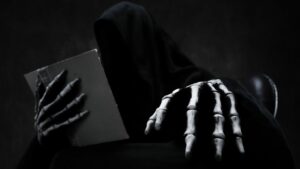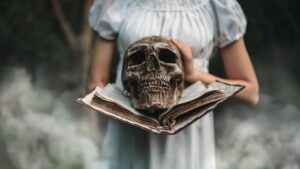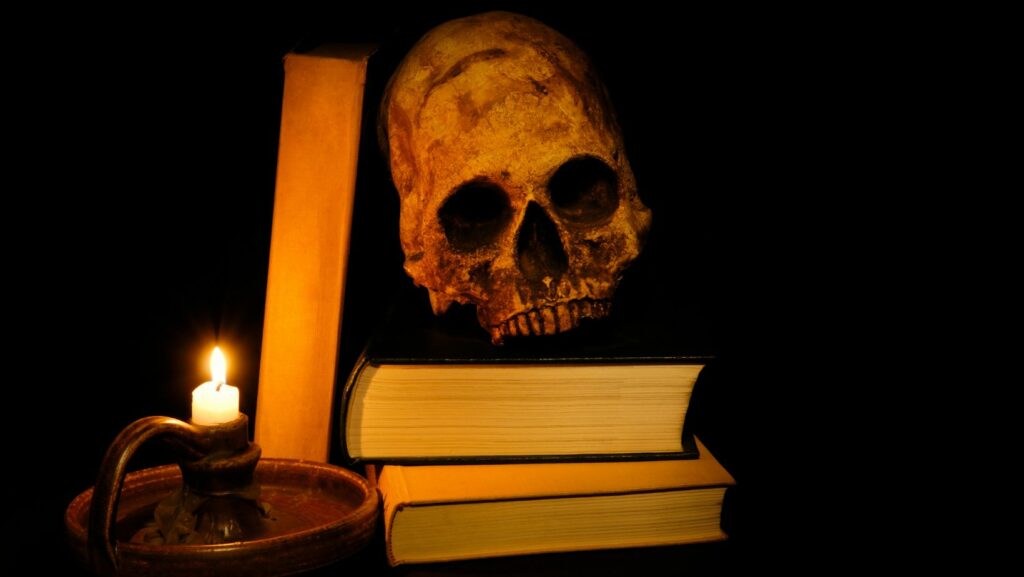Horror Book Genres
- Diverse Subgenres: Horror literature includes various subgenres like psychological horror, supernatural horror, and folklore horror, each offering unique themes and emotional experiences.
- Character and Conflict: Strong character development and the struggle against fear or evil are central to horror narratives, creating relatable protagonists and complex antagonists.
- Atmosphere and Setting: Effective use of dark, eerie settings enhances suspense and immerses readers in the chilling experiences characteristic of the genre.
- Themes of Fear: Common themes in horror literature encompass existential dread, mortality, and the battle between good and evil, resonating with readers on a personal level.
- Influential Authors: Notable authors like Stephen King, Shirley Jackson, and H.P. Lovecraft have significantly shaped the genre, exploring deep psychological themes and universal fears.
 Horror books have a unique ability to tap into our deepest fears and anxieties, offering a thrilling escape into the unknown. From the eerie atmosphere of classic Gothic tales to the psychological twists of modern thrillers, the genre has evolved dramatically over the years. Readers are drawn to the adrenaline rush that comes with exploring the macabre and the supernatural.
Horror books have a unique ability to tap into our deepest fears and anxieties, offering a thrilling escape into the unknown. From the eerie atmosphere of classic Gothic tales to the psychological twists of modern thrillers, the genre has evolved dramatically over the years. Readers are drawn to the adrenaline rush that comes with exploring the macabre and the supernatural.
Within the realm of horror, various subgenres cater to diverse tastes. Whether it’s the chilling suspense of psychological horror or the blood-curdling excitement of slasher fiction, each offers a distinct experience. This exploration of horror book genres reveals how these narratives not only entertain but also challenge perceptions of fear and humanity itself.
Overview Of Horror Book Genres
Horror book genres encompass a wide range of narratives designed to evoke fear and intrigue. These works challenge perceptions of reality, explore human psychology, and tap into primal fears.
Definition And Characteristics
Horror literature centers on the element of fear, employing suspense and dread while leading readers into unsettling scenarios. Characteristics include:
- Atmosphere: Dark, eerie settings enhance tension.
- Themes: Common themes involve death, the supernatural, and existential dread.
- Characters: Protagonists face malevolent forces or deep-seated psychological issues.
- Conflict: The struggle against fear or evil drives the plot forward.
- Imagery: Vivid descriptions create visceral experiences meant to elicit strong emotional responses.
- Gothic Literature: Early works like “The Castle of Otranto” (1764) emphasized supernatural elements and psychological terror.
- Victorian Era: Writers such as Mary Shelley and Bram Stoker introduced themes of monstrosity and humanity’s darker side.
- 20th Century Evolution: The genre diversified with subgenres like science fiction horror and psychological horror, exemplified by authors like H.P. Lovecraft and Shirley Jackson.
- Modern Trends: Contemporary horror embraces societal fears, often reflecting current events and anxieties, leading to diverse narratives and styles.
Popular Horror Book Genres
Horror literature encompasses a variety of genres, each designed to evoke distinct emotions and thrills. Below are some of the most popular horror book genres that continue to captivate readers.
Psychological Horror
Psychological horror focuses on the mental and emotional turmoil of characters. It explores themes of madness, paranoia, and alienation. This genre emphasizes internal fears, often blurring the lines between reality and imagination. Notable examples include “The Shining” by Stephen King and “The Silent Patient” by Alex Michaelides. These narratives evoke discomfort through the characters’ psychological struggles and often leave readers questioning their own perceptions.
Supernatural Horror
Supernatural horror centers around otherworldly elements, such as ghosts, demons, or mystical creatures. This genre taps into the fear of the unknown and examines humanity’s relationship with the supernatural. Works like “The Haunting of Hill House” by Shirley Jackson and “The Exorcist” by William Peter Blatty showcase terrifying scenarios involving the paranormal. Supernatural horror combines suspense with a sense of dread, captivating readers through its exploration of phenomena beyond the natural world.
Folklore Horror
Folklore horror draws on myths, legends, and cultural tales to create chilling narratives. This genre often incorporates traditional stories and regional fears, highlighting universal themes of morality and the uncanny. Titles such as “Mexican Gothic” by Silvia Moreno-Garcia and “The Fisherman” by John Langan exemplify this genre’s power. Folklore horror resonates deeply with readers, as it connects personal fears with collective cultural narratives, offering a unique lens into societal anxieties.
Key Elements Of Horror Literature
Horror literature captivates readers through its distinctive elements. These components intertwine to evoke fear and suspense, enhancing the overall reading experience.
Atmosphere And Setting
Atmosphere and setting play crucial roles in horror literature. Authors often create dark, eerie environments that heighten tension and immerse readers. Common elements include desolate landscapes, ominous weather, and decaying architecture. The use of sensory details paints vivid imagery, stirring emotions and amplifying fear. For example, isolated woods or a haunted mansion can provoke a sense of dread and uncertainty. Effective use of setting contributes significantly to the narrative’s chilling effect.
Character Development
Character development is essential in horror stories. Strong, relatable characters engage readers and make the narrative more impactful. Horror often features protagonists who grapple with inner demons or face external threats. Their emotional journeys create empathy and heighten tension. Villains or antagonistic forces, often complex, drive conflict and intrigue. The background of characters also plays a vital role; flawed protagonists or sympathetic villains can intensify the reader’s investment in the story.
Themes And Motifs
Themes and motifs are integral to horror literature. Recurring motifs, such as isolation, madness, and the supernatural, create a sense of familiarity while reinforcing the fear. Common themes include the struggle between good and evil, mortality, and the unknown. Writers often explore the fragility of sanity and the impact of societal fears on the individual. These themes resonate deeply with readers, connecting their experiences to broader existential questions while intensifying the haunting ambiance of the genre.
Notable Authors And Their Contributions
Horror literature features several influential authors who shaped the genre through their unique storytelling and thematic explorations. Their works resonate deeply with readers, pushing the boundaries of fear and imagination.
Stephen King
Stephen King stands as a titan in horror literature, known for crafting compelling narratives that explore the human psyche’s darkest corners. With over 60 published novels, his contributions include classics like “It,” a tale of childhood fears manifesting as a malevolent entity, and “The Shining,” which delves into isolation and madness. King’s mastery lies in his ability to intertwine supernatural elements with relatable characters, making the horrific feel familiar. His exploration of societal fears and personal demons has established him as a leading figure in modern horror.
Shirley Jackson
Shirley Jackson’s work is characterized by psychological depth and unsettling atmospheres. Her influential novel, “The Haunting of Hill House,” explores themes of fear, isolation, and the impact of trauma within a haunted setting. Jackson’s storytelling technique often leaves readers questioning reality, as seen in her short story “The Lottery,” which examines conformity and societal norms. Her contributions to psychological horror remain significant, as she adeptly blends the ordinary with the extraordinary, generating lasting unease.
H.P. Lovecraft
 H.P. Lovecraft significantly impacted the horror genre through his creation of cosmic horror, emphasizing humanity’s insignificance in the universe. His works, such as “The Call of Cthulhu,” showcase ancient, malevolent beings and the fragility of sanity when confronted with the unknown. Lovecraft’s use of atmosphere and dread has inspired countless authors, establishing a foundation for modern horror. His focus on existential dread and the supernatural has shown that true horror often resides beyond human comprehension.
H.P. Lovecraft significantly impacted the horror genre through his creation of cosmic horror, emphasizing humanity’s insignificance in the universe. His works, such as “The Call of Cthulhu,” showcase ancient, malevolent beings and the fragility of sanity when confronted with the unknown. Lovecraft’s use of atmosphere and dread has inspired countless authors, establishing a foundation for modern horror. His focus on existential dread and the supernatural has shown that true horror often resides beyond human comprehension.
Horror Literature Continues to Captivate Readers by Exploring the Depths of Fear and the Unknown
Horror literature continues to captivate readers by exploring the depths of fear and the unknown. With its rich history and diverse subgenres it offers something for everyone seeking thrills and chills. Whether through psychological tension supernatural elements or folklore-inspired tales these narratives resonate on a personal level while reflecting societal anxieties.
The genre’s evolution showcases the creativity of authors who challenge conventions and push boundaries. As horror continues to adapt to contemporary themes it remains a powerful medium for both entertainment and introspection. Readers can expect to find new and exciting stories that not only terrify but also provoke thought and discussion long after the last page is turned.



